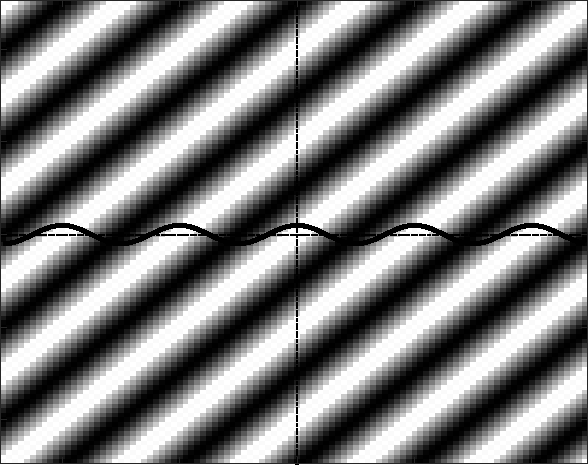This section develops a special case of Wave Field Synthesis (WFS) by spatially sampling simple plane waves. Sampling plane waves is much simpler than the traditional WFS formulation which begins with the classical Kirchhoff-Helmholtz integral (Firtha, 2018; Pierce, 1989). In return for this simplicity, we are restricted to virtual primary sources that are many wavelengths away from the speaker array, and on the other side of it from the listener. As we shall see, we can relax these restrictions in various ways, and the remaining sampling conditions are generally equally binding for WFS systems. In other words, spatial sampling theory is fundamental to all spatial audio systems using discrete drivers arranged in linear, planar, or even more general array geometries. What does not seem to be generally known, however, is that a sampling-based approach is sufficient (and much more to the point) for deriving and optimizing the system, as pursued in this paper.
Figure 2 shows a monochromatic plane wave traveling down and
to the right at a 45 degree angle. The solid black line across the
middle represents the microphone-array, ideally a uniformly spaced
grid of tiny omnidirectional pressure microphones having no ``acoustic
shadow'' at all; these microphones serve to sample the plane
wave along the line. In the 3D case, the line represents one cut
along a planar microphone-array. The sinusoid drawn along the
microphone line indicates the pressure seen by each microphone. By
the sampling theorem (applied now to spatial sampling using a
microphone-array), we must have more than two microphones per
wavelength ![]() along the line array. Thus, the required microphone
density is determined by the minimum incident wavelength
along the line array. Thus, the required microphone
density is determined by the minimum incident wavelength
![]() and
the maximum angle of incidence
and
the maximum angle of incidence
![]() , as derived below.
, as derived below.

|
Figure 3 illustrates the geometry of the wavelengths involved.
The wavelength of the incident sinusoidal plane wave is denoted
![]() , and
, and ![]() denotes the wavelength of the sinusoidal pressure
fluctuation seen by the microphone line array. As Fig.3
makes clear, from the angle of incidence
denotes the wavelength of the sinusoidal pressure
fluctuation seen by the microphone line array. As Fig.3
makes clear, from the angle of incidence ![]() and incident
wavelength
and incident
wavelength ![]() , we have
, we have
 |
(1) |
 |
(2) | ||
 |
(3) |
For example, choosing
![]() kHz and
kHz and
![]() (stage
angle 90 degrees), and using
(stage
angle 90 degrees), and using ![]() m/s for sound speed, we obtain
m/s for sound speed, we obtain
![]() mm, or about half-inch spacing for the microphones. (The
coincident speaker-array has the same sampling-density requirement as
the microphone-array.)
mm, or about half-inch spacing for the microphones. (The
coincident speaker-array has the same sampling-density requirement as
the microphone-array.)
Reducing either
![]() or
or
![]() relaxes the spatial sampling
density requirement. For example, if the ``stage width'' is reduced
from 90 degrees (
relaxes the spatial sampling
density requirement. For example, if the ``stage width'' is reduced
from 90 degrees (
![]() ) down to 40 degrees (
) down to 40 degrees (
![]() ), then one-inch spacing of the
microphones (and speakers) is allowed. If we band-limit our
reconstruction bandwidth to 5 kHz, then we get by with four-inch
spacing, as pursued below in a practical PBAP design
(§2.15).
), then one-inch spacing of the
microphones (and speakers) is allowed. If we band-limit our
reconstruction bandwidth to 5 kHz, then we get by with four-inch
spacing, as pursued below in a practical PBAP design
(§2.15).
If we don't band-limit to below the spatial Nyquist limit, then we obtain ``spatial angle aliasing'' at very high frequencies for sources near the left or right edge of the ``stage viewing window''. That is, for sources near the left or right edges of the ``stage'', the highest-frequency components may not appear to come from the same direction as components below the cutoff frequency of 5 kHz. On the other hand, perception is such that the apparent angle-of-arrival typically may not alias at high frequencies because the desired angle remains a psychoacoustic choice and keeps the whole source spectrum in one place. Sources near the center of the stage are spatially oversampled by the microphone-array at all frequencies, so they are never a problem. In lowpassed-wideband-noise tests (see Appendix A), high-frequency spatial aliasing has been observed to break up a formerly coherent wideband virtual noise source, but not in a manner indicating ``folding'' as in aliasing of tones due to temporal sampling, but instead as the sound of a spurious new noise source somewhere along the array. The psychoacoustics of spatial aliasing perception is a fascinating topic for ongoing research.
http://arxiv.org/abs/1911.07575.